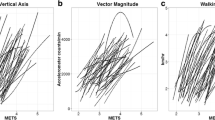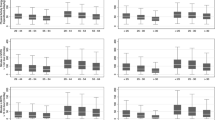Abstract
This study determined whether some of the more vigorous household and garden tasks (sweeping, window cleaning, vacuuming and lawn mowing) were performed at a moderate intensity (3–6 METs or metabolic equivalents) by a representative sample of 50, 55 to 65-year-old women ( \(\overline{{\hbox{X}}}\pm \hbox{SD};\) 59.3 ± 3.1 years, 161.5 ± 5.2 cm, 69.4 ± 12.4 kg, 38.4 ± 7.3% BF). Data collection was conducted in a standardised laboratory environment and in the subjects’ homes. Energy expenditure during self-perceived moderate paced walking around a quadrangle was also used as a marker of exercise intensity. Energy expenditure measured via indirect calorimetry was also predicted from: HR, CSA accelerometer counts, Quetelet’s index and the Borg rating of perceived exertion. Ninety-six percent of the subjects walked at an intensity of ≥ 3.0 METs. Except for vacuuming in the laboratory ( \(\overline{\text{X}} =2.9\) METs; P = 0.19), the intensity of each of the other activities was significantly (P ≤ 0.002) greater than 3.0 METs. Subjects swept (3.7 vs. 3.3 METs) and vacuumed (3.6 vs. 2.9 METs) at greater intensities in the home than in the laboratory, whereas the converse applied to window cleaning (3.3 vs. 3.6 METs) and lawn mowing (4.9 vs. 5.5 METs). Eighty-six percent (172 out of 200) of the \(\dot{\text{V}}{\hbox{O}_{2}}\) measurements were ≥ 3.0 METs when the four household/garden activities were performed in the subjects’ homes. These activities therefore have the potential to contribute to the 30 min day−1 of moderate intensity physical activity required to confer health benefits but there was much inter-individual variability in the intensity at which these tasks were performed. Random intercept regression analyses yielded prediction equations with 95% confidence intervals of ± 0.80 and ± 0.84 METs for the laboratory and home based equations, respectively. Considering the means for the five activities ranged from 2.9 to 5.5 METs, these 95% confidence intervals lack predictive precision at the individual level. Nevertheless, the laboratory and home-based equations predicted with correct classification rates of 89 and 90%, respectively, whether energy expenditure was < 3.0 or ≥ 3.0 METs.



Similar content being viewed by others
References
Armstrong T, Bauman A, Davies J (2000) Physical activity patterns of Australian adults. Results of the 1999 National Physical Activity Survey. Canberra, Australian Institute of Health and Welfare, p 27
Australian Bureau of Statistics (ABS) (2001) National Health Survey, Summary of results, Australia 1989–90, 1995 and 2001. ABS, Canberra, pp 82–83
Bland JM, Altman DG (1986) Statistical methods for assessing agreement between two methods of clinical measurement. Lancet 1:307–310
Brooks AG, Withers RT, Gore CJ, Vogler AJ, Plummer J, Cormack J. (2004) Measurement and prediction of METs during household activities in 35- to 45-year-old females. Eur J Appl Physiol 91:638–648
Commonwealth Department of Health and Aged Care (CDHAC) (1999) National physical activity guidelines for Australians. CDHAC, Canberra
Dobson AJ (1984) Calculating sample size. Trans Menzies Found 7:75–79
Elia M and Livesey G (1992) Energy expenditure and fuel selection in biological systems: the theory and practice of calculations based on indirect calorimetry and tracer methods. Metabolic control of eating, energy expenditure and the bioenergetics of obesity. AP Simopoulos. Karger, Basel, p 89 (equation 6)
Gunn SM, Brooks AG, Withers RT, Gore CJ, Owen N, Booth ML, Bauman AE (2002) Determining energy expenditure during some household and garden tasks. Med Sci Sports Exerc 34:895–902
Gunn SM, van der Ploeg GE, Withers RT, Gore CJ, Owen N, Bauman AE, Cormack J (2004) Measurement and prediction of energy expenditure in males during household and garden tasks. Eur J Appl Physiol 91:61–70
Gunn SM, Brooks AG, Withers RT, Gore CJ, Plummer JL, Cormack J (2005) The energy cost of household and garden activities in 55–65 year old males. Eur J Appl Physiol 94:476–486
Harrell FEJ (2001) Regression modeling strategies. With application to linear models, logistic regression, and survival analysis. Springer, Berlin Heidelberg New York, pp 93–94
Hart JD and Withers RT (1996) The calibration of gas volume measuring devices at continuous and pulsatile flows. Aust J Sci Med Sport 28:61–65
Haskell WL, Yee MC, Evans A, Irby PJ (1993) Simultaneous measurement of heart rate and body motion to quantitate physical activity. Med Sci Sports Exerc 25:109–115
Hawkins SA and Wiswell RA (2003) Rate and mechanism of maximal oxygen consumption decline with aging: implications for exercise training. Sports Med 33:877–888
Healy MJR (2001) Multilevel data and their analysis. Multilevel modelling of health statistics. In: Leyland AH, Goldstein H (eds) Wiley, New York, pp 1–12
Luke A, Maki KC, Barkey N, Cooper R, McGee D (1997) Simultaneous monitoring of heart rate and motion to assess energy expenditure. Med Sci Sports Exerc 29:144–148
Melanson EL Jr, Freedson PS (1995) Validity of the computer sciences and applications, Inc (CSA) activity monitor. Med Sci Sports Exerc 27:934–940
Pate RR, Pratt M, Blair SN, Haskell WL, Macera CA, Bouchard C, Buchner D, Ettinger W, Heath GW, King AC, Kriska A, Leon AS, Marcus BH, Morris J, Paffenbarger RS, Jr., Patrick K, Pollock ML, Rippe JM, Sallis JF and Wilmore JH (1995) Physical activity and public health. A recommendation from the Centers for Disease Control and Prevention and the American College of Sports Medicine. JAMA 273:402–407
Strath SJ, Bassett Jr DR, Swartz AM, Thompson DL (2001) Simultaneous heart rate-motion sensor technique to estimate energy expenditure. Med Sci Sports Exerc 33:2118–2123
Tanaka H, Monahan KD, Douglas SR (2001) Age-predicted maximal heart rate revisited. J Am Coll Cardiol 37: 153–156
U.S Department of Health and Human Services (1996) Physical activity and health: a report of the Surgeon General. Atlanta, GA: U.S. Department of Health and Human Services, Centres for Disease Control and Prevention, National Centre for Chronic Disease Prevention and Health Promotion, ISSN: 017023001965
U.S Department of Health and Human Services, Public Health Service, Centres for Disease Control and Prevention, National Centre for Chronic Disease Prevention and Health Promotion, Division of Nutrition and Physical Activity (1999) Promoting physical activity: a guide for community action. Human Kinetics, Champaign, IL, ISBN 0736001522, p 29
Acknowledgments
This study was supported by a grant form the National Health and Medical Research Council of Australia.
Author information
Authors and Affiliations
Corresponding author
Rights and permissions
About this article
Cite this article
Withers, R.T., Brooks, A.G., Gunn, S.M. et al. Self-selected exercise intensity during household/garden activities and walking in 55 to 65-year-old females. Eur J Appl Physiol 97, 494–504 (2006). https://doi.org/10.1007/s00421-006-0177-x
Accepted:
Published:
Issue Date:
DOI: https://doi.org/10.1007/s00421-006-0177-x




